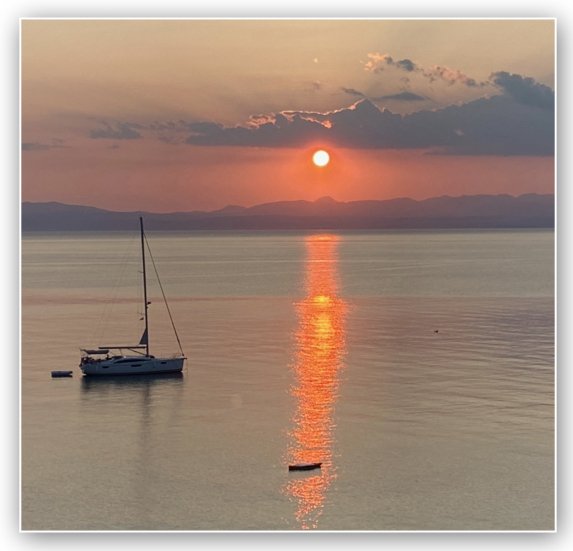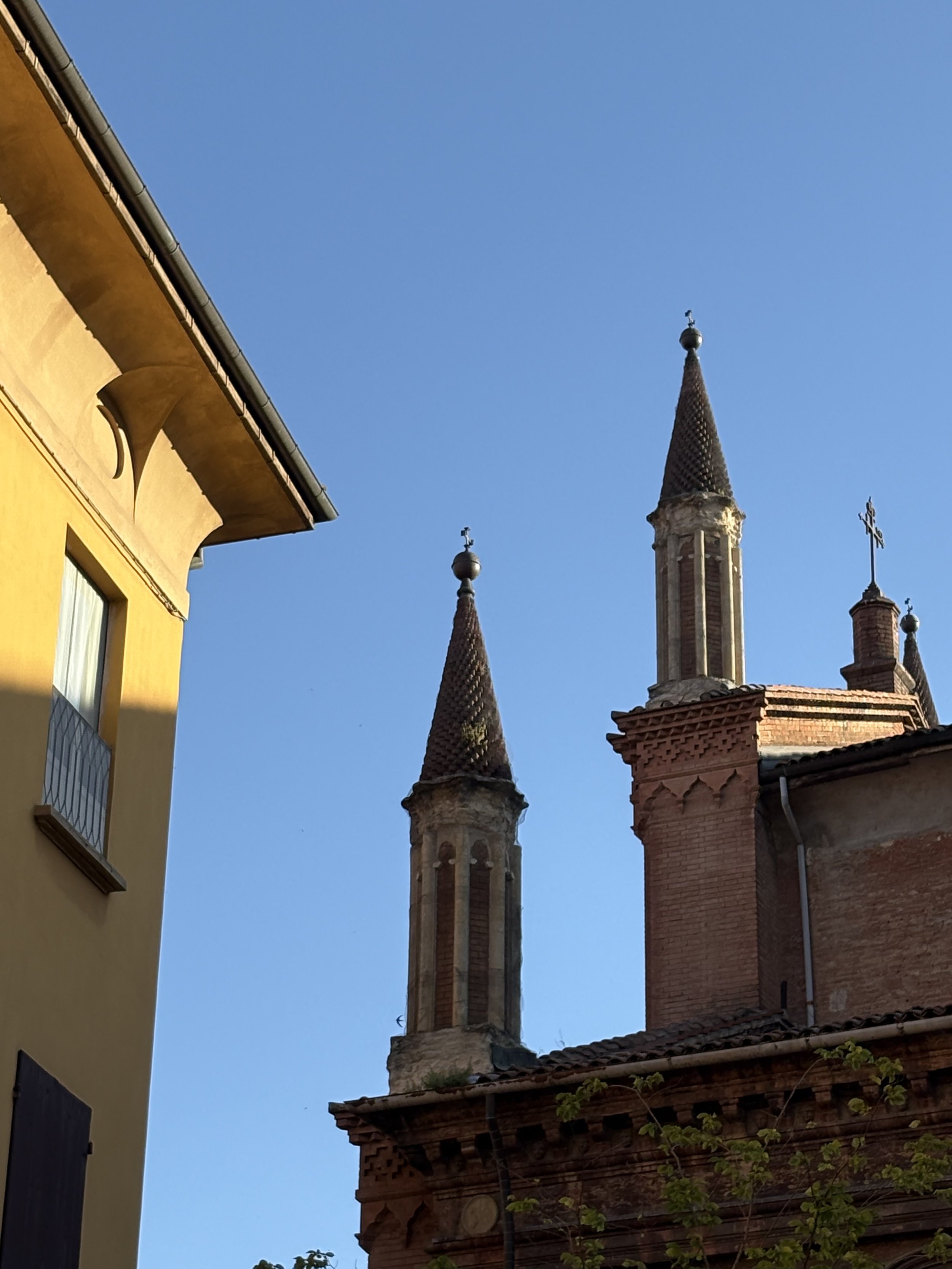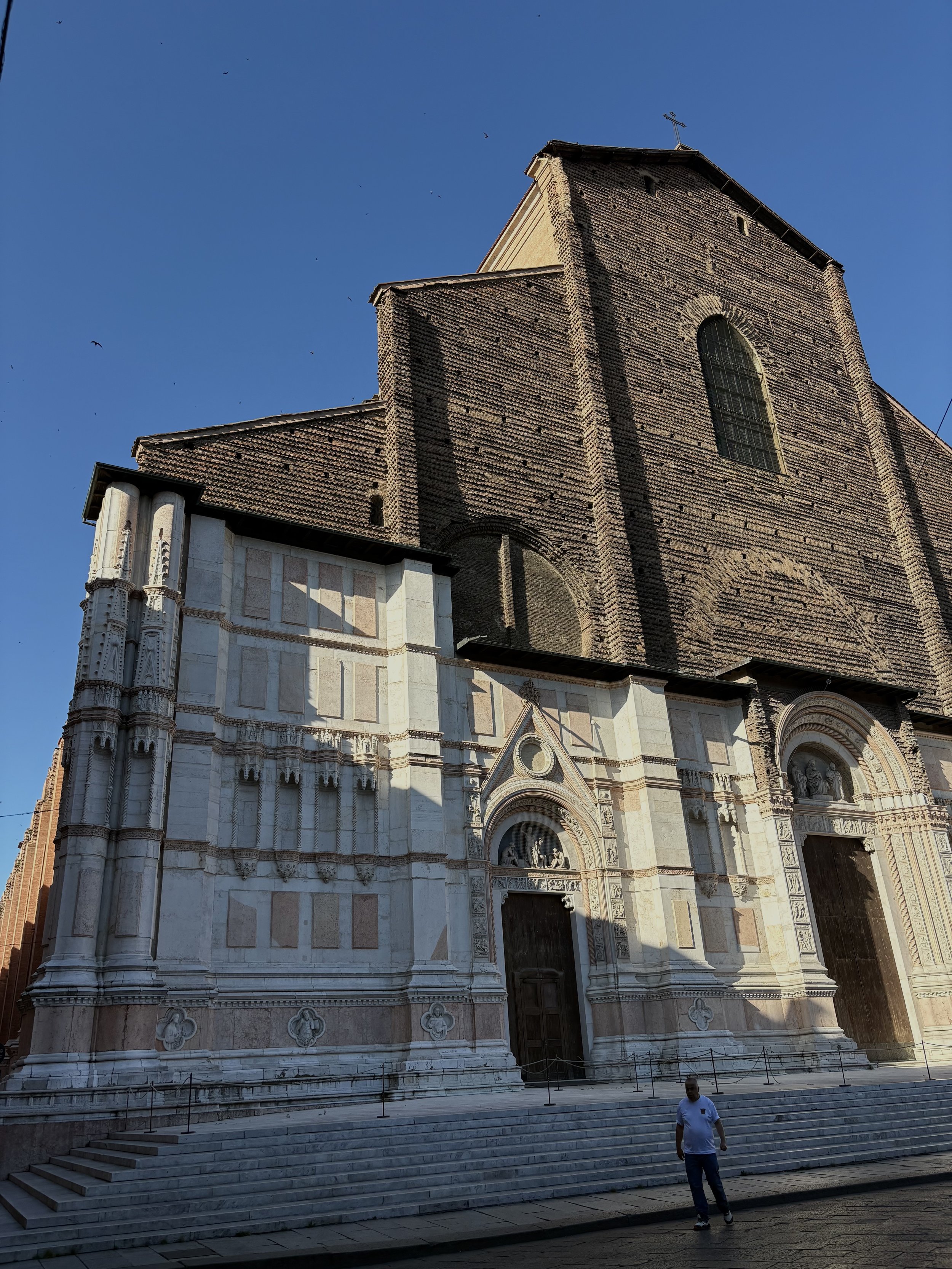36 Hours in Bologna
Among so many other things, Italy is known for food. And Bologna, in the Emilia-Romagna region, between Florence and Venice, is known as the food capital of Italy.
For me that was reason enough to make the city a top destination on our list.
But while we went for the cuisine, we were pleasantly surprised by everything else Bologna had to offer. It’s kind of like a city with a village vibe — plenty of narrow, winding streets to stroll through, each neighborhood revealing its own points of interest, from historical sites to art, architecture and, of course, opportunities to indulge the palate.
Beautiful churches and piazzas are literally everywhere, along with medieval towers and buildings painted in vibrant shades of yellow, ochre and red. I read that Bologna is home to the oldest university in the world, and that added to its eclectic mix of youthful energy and old-world charm.
Another interesting feature is Bologna’s porticoes — covered walkways found throughout the city. There are something like 60 kilometers of them, many displaying ornate architecture with high, vaulted ceilings, some painted with beautiful frescoes.
My one regret is that we were only in Bologna for a single afternoon and a day, barely enough time to scratch the surface. But after walking over 35,000 steps, we were able to see and do enough to know we will absolutely go back.
First Impressions
Ok I’ll start with the not-so-delectable news. It’s possible to have a mediocre meal even in places with a reputation for incredible food, and Bologna is no exception.
We arrived after a long day of travel and everyone in our group — myself, my wife, teen daughter and her friend — was tired and hungry. It was too early for dinner so we decided to go out, grab a quick bite, and make a foray into the town.
Against my better judgement, we stopped at the first place that looked decent….and it was anything but. We started with prosciutto and melon, which wasn’t bad. I ordered a salad for my meal but everyone else got pasta and they barely ate any of it. My daughter’s Taglietelle Bolognese was a disappointment, and my wife’s pasta came swimming in a gooey cream sauce. My daughter’s friend ordered a cacio e pepe and she left most of it untouched.
Adding insult to injury, we later discovered some of the best salumerias in the city were just around the corner, literally steps from our table. Lesson learned — don’t make hasty food decisions when you’re hungry. It usually doesn’t end well.
After that I was left in charge of our dining plans. So while the ladies went shopping, I hunted for a place to have a proper Bolognese meal. Our AirBnB host provided a list of his favorite restaurants so I started there. I checked out a few of his recommendations and settled on Ristorante Cesarina, right on the Piazza Santo Stefano.
We arrived a few hours later for dinner and were promptly shown to our table, set up on the cobblestone street outside. The restaurant was a bit more formal than we expected — white tablecloths, wait staff smartly dressed — but it all felt welcoming and comfortable. The piazza was illuminated in warm light with the sunset sky gradually fading through the deepest of blue to black.
I started with an artichoke salad simply dressed with lemon and olive oil, and topped with shaved Parmiggiano Reggiano. My wife doesn’t much care for artichokes but she dug in and helped me finish the whole thing. It was a demonstration of how simple ingredients, chosen for their freshness and quality, can far exceed the sum of their parts.
I then did something I rarely do since I try to pay attention to my carbohydrate intake. I ordered a Bolognese classic - Lasagna Verde. Sheets of homemade green (spinach) pasta stacked between alternating layers of bechamela and Bolognese sauce. It was nothing if not sublime. For whatever reason it wasn’t heavy but light and luscious, and the portion was just right.
My daughter and her friend ordered the fillet steak with green peppercorn sauce. They inhaled their meals before I could sample a forkful but pronounced them “fire.”
I will forever remember Ristorante Cesarina as my introduction to real Bolognese cooking. Henceforward, it will be our first stop whenever we return.
Morning Walk
Next morning, a Saturday, I woke up early and hit the pavement looking for coffee. Nothing was open at that hour but my search took me down several side streets. The morning light and shadows played off the vibrant colors of the buildings, creating non-stop photo opportunities.
I walked past the Two Towers, built in the 12th century by competing Bolognese families as a display of wealth. The taller is known as the Asinelli Tower, standing at a height of 319 feet. The shorter Garisenda Tower leans at a precarious angle and looks like it could topple over at any moment. Apparently it was once possible to climb the towers but now they’re closed due to the danger of collapse.
I then stumbled upon the Little Venice area of the city. Back in the day Bologna’s water flowed through narrow canals between the old buildings, but in the 20th century most of them were covered over by newer streets. Here you can still glimpse one or two remaining canals.
I eventually wandered into the Mercato Quadrilatero, a daily open market in one of the most ancient areas of the city. While other neighborhoods were only just waking up, the market vendors here were open for business, proudly displaying local produce, piles of fresh fish and seafood, homemade pastas in a variety of shapes, cheeses and, of course, the incredible salumi of Bologna.
Market shoppers and purveyors need their coffee in the morning and there were a couple of cafes doing a brisk trade — small establishments tucked away among the market stalls, waiters carrying shots of espresso to the street vendors outside. I popped into one, ordered a macchiato, and sipped it standing at the counter like a local. I had a cappuccino at the other place just around the corner. Both served great coffee and I wish I remembered their names.
After exiting the market area it was a short walk to the Piazza Maggiore, a landmark square in the center of the old city, surrounded by impressive buildings designed in the Gothic and Renaissance styles. While not the most beautiful church I’ve seen, the massive Basilica San Petronio is unique for its unfinished brick facade. Inside on the floor there’s a meridian line placed by Cassini in 1655. A hole in the roof projects the rays of the sun onto the line every day at noon. (I wish I had been there to see that).
Right next to the Piazza Maggiore is the Fountain of Neptune, which was created at the request of the Pope in the 16th century as a tribute to his power. (Seems odd that a Catholic Pope would choose a pagan god to represent his influence; or that a Pope would indulge himself with that level of vanity; but hey, who am I to judge?)
I made my way back to our AirBnB via the Piazza Santo Stefano which, in my opinion, is even more impressive than the Piazza Maggiore. This area is also known as the Seven Churches for the stunning buildings arrayed around the square, each unique in its design and architectural style.
Mangiare!
By the time the rest of our group rolled out of bed, it was nearly time for lunch. We had planned to eat at Sfoglia Rina, which multiple sources recommended. But there was a 40-minute wait so I directed us back toward Il Quadrilatero, and Salumeria Simoni. This was quite possibly the simplest but most delicious meal we had on our entire two-week trip to Italy.
The outdoor tables were nearly all full with jovial groups enjoying their food — always a good sign. We found one recently-vacated table for four and started with focaccia topped with tomato, which was decadent. We then each ordered a panini filled with Simoni’s signature meats. I went for the porchetta with burrata and pesto. My wife got prosciutto, and the two girls each ordered roast beef. (I know, roast beef in Italy? What the?)
The paninis were made with fresh bread still warm from the oven, and they were stuffed with the most succulent, incredibly tasty meat products I have ever experienced anywhere. Only in Bologna can they raise a simple sandwich to such a level of unmitigated goodness.
After lunch I convinced the two girls to indulge me in a visit to the Archaeological Museum, known for its Egyptian, Greek, Roman and Etruscan collections. Mea Culpa, I actually bribed the young ones with a promise of gelato afterward. (My wife took a rain check and went shopping)
The museum was wonderful but not air conditioned and after an hour we were ready to go. Sable Gelato was calling our names and it was well worth the walk in the searing afternoon sun. The owners were a young couple who’d earned international recognition for their high quality ice creams, using locally-sourced ingredients to create unique and interesting flavors. The girls each ordered a combination of matcha orange blossom and raspberry, while I got the amarena and crema Bolognese. Not to be outdone by all the other amazing food in Bologna, Sable Gelato shined — a fantastic finish to an incredible day.
Our final meal in Bologna that night was at Trattoria Anna Maria, an old-school, traditional eatery, with all the classics on offer. I had to try the Tagliatelle Bolognese, which was good but not what I expected. This being the signature dish of the city, the reason I first took an interest in going there in the first place, I guess I just assumed it would knock my socks off. But ironically, of all the reasons to love Bologna, it just wasn’t at the top of my list.
Then again, maybe we just hit the place on an off night. Or maybe there’s another little osteria or trattoria somewhere on one of those side streets that we’ve yet to discover. Reason enough to make our way back — and soon. Prego!
The Highlights
Ristorante Cesarina — Fantastic food and impeccable service overlooking the Piazza Santo Stefano
Salumeria Simoni — Bologna’s salumi elevated to a higher level
Sfoglia Rina — We didn’t have the opportunity to try it but highly recommended
Trattoria Anna Maria — Traditional Bolognese cooking serving all the classics
Sable Gelato — Award-winning ice cream made with love and local ingredients
Mercato Quadrilatero — A daily market in one of the oldest neighborhoods of Bologna
Piazza Maggiore — In the heart of the old city
Basilica San Petronio — In the Piazza Maggiore
Fountain of Neptune — Dedicated by the Pope in the 16th century
The Two Towers — Built in the 12th century. See them before they topple over
Piazza Santo Stefano — A stunning spot also known as the Seven Churches
Porticoes — Over 60 km of them throughout the city
Little Venice — Where you can still see old canals that once brought water to the city




























